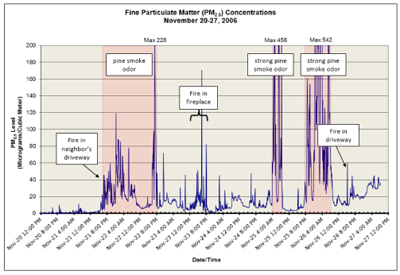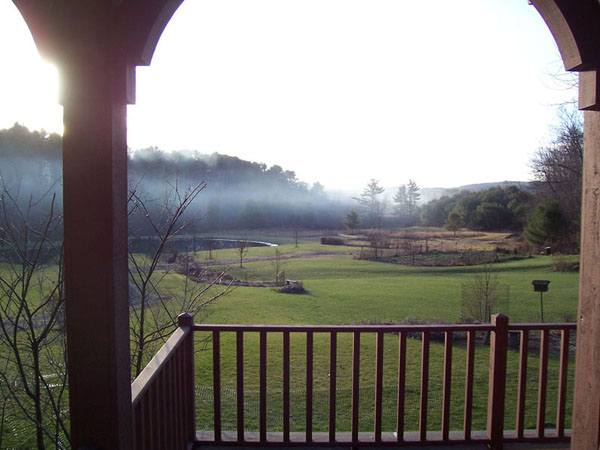Outdoor Air Testing Downwind of an Outdoor Wood Boiler
Overview
The New York State Department of Health conducted a pilot project in 2006/2007 as part of a larger study to measure the impact of smoke from outdoor wood boilers (OWBs) on the levels of fine particulate matter (PM2.5) in outdoor air.
The Testing
The Department performed the pilot project air testing at a home located:
- over 1,000 feet away from an operating OWB,
- in a rural setting, and
- downhill from the OWB, in a narrow valley.
Testing lasted for several weeks. We used an instrument, called a DataRAM, that measures real-time levels of PM2.5 in air. We recorded five minute average levels over the entire monitoring period.
Although PM2.5 is a good indicator of smoke, it is only one component of smoke pollution. Wood smoke also contains:
- carbon monoxide,
- carbon dioxide,
- and many different chemicals (including aldehydes, acid gases, sulfur dioxide, nitrogen oxides, polycyclic aromatic hydrocarbons, benzene, toluene, styrene, metals and dioxins).
The type and amount of particles and chemicals in smoke varies depending on:
- what is burning,
- how much oxygen is available, and
- the burn temperature.
The Data
We graphed the data to illustrate the measured PM2.5 levels. The graph below shows the levels from the afternoon of November 20 through the morning of November 27, 2006.

The peaks and valleys on the graph show how the PM2.5 levels fluctuated throughout the monitoring period. There are several factors that explain why the PM2.5 levels rise and fall, including the way OWBs operate, cycling between a full, hot burn (less smoke) and a smoldering fire (more smoke). Wind patterns and other weather conditions also can affect how smoke travels through the air.
The graph shows that PM2.5 levels were as high as 542 micrograms per cubic meter during a smoke event, contrasted with levels as low as 1 microgram per cubic meter when there are no smoke odors present. Fine particulate matter poses a concern for people's health, when levels in air are high.
The Observations

Observations made during the testing showed that PM2.5 levels were highest:
- when strong pine smoke odors from the OWB were present, and
- during the early evenings, night time and early morning hours, when the atmosphere is more stable (calm) and smoke was close to the ground and followed the shape of the land. This kind of smoke movement can be seen in the photograph.
These data show the measured PM2.5 levels for this particular situation. Measurements collected at a different location (e.g., not downslope in a narrow valley), closer or farther from an OWB, under different weather conditions, and under different OWB operating conditions would be different.
Additional graphs of PM2.5 data from this pilot project are available.
More Information
The results and experience obtained during this pilot project were used to refine the methods for the study, Fine Particulate Matter Concentrations in Outdoor Air Near Outdoor Wood-Fired Boilers, released in 2013.
If you would like additional information about this study or the health effects of fine particles, please call the Department of Health at 518-402-7800 or 800-458-1158.